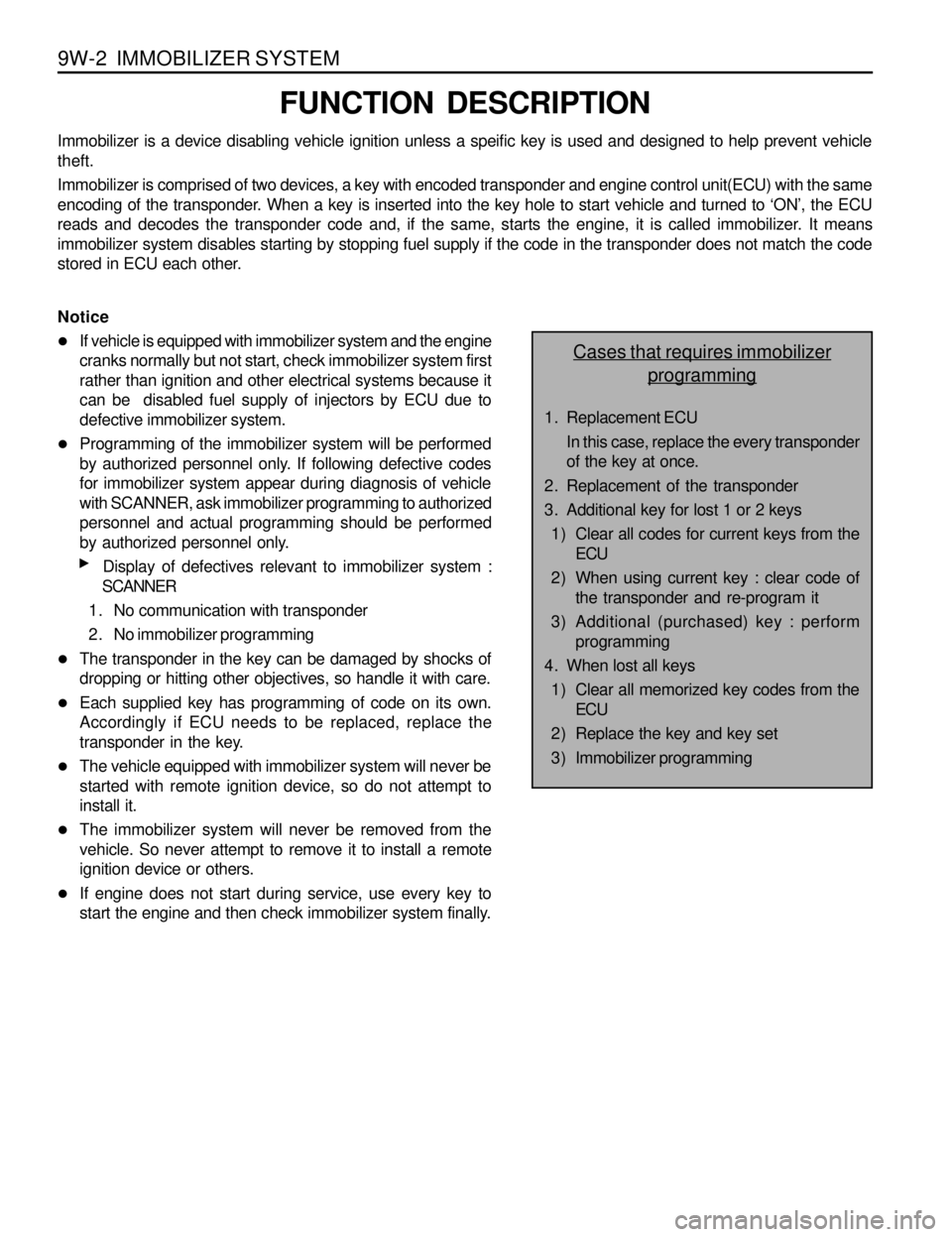1998 SSANGYONG MUSSO stop start
[x] Cancel search: stop startPage 938 of 1463

POWER BOOSTER 4C-5
PEDAL STROKE INSPECTION
1. Start the engine and stop it after one or two minutes.
Depress the brake pedal several times.
If the pedal goes down furthest the first time, but gradually
rises after the second or third time, brake booster is normal.
If there is no change in pedal stroke, the brake booster is
abnormal.
2. Depress the brake pedal several times with engine stopped,
and depress the brake pedal and start the engine. If the
pedal goes down slightly, the booster is normal.
3. Depress the brake pedal with engine running, and stop it
with the pedal depressed. If there is no change in pedal
height during 30 sec., the booster is normal.
Page 1057 of 1463

5A-80 AUTOMATIC TRANSMISSION
6. Switch off the engine and raise the vehicle on the hoist, if applicable, ensuring that the vehicle is level.
7. Three minutes after the engine has stopped, but no longer than one hour, remove the filler pump, The correct
level is reached when ATF is aligned with the bottom of the filler hole. If the correct level is not reached, then add
a small quantity of ATF to the correct level.
8. Replace the transmission filler plug and clean all remnants of ATF on the transmission and vehicle.
9. Tighten the transmission filler plug to specification.
Checking, Adding Fluid and Filling - Drained or Dry Transmission
To set the correct fluid level proceed as follows.
1. Set the transmission selector to Park and switch the engine off.
2. Raise the vehicle on a hoist (or leave over a service pit).
3. Clean all dirt from around the service fill plug prior to removing the plug, Remove the oil service fill plug. Clean the
fill plug and check that there is no damage to the ‘O’ ring. Install the filler pump into the filler hole.
4. Lower the vehicle with the filler pump still connected and partially fill the transmission. This typically requires
approximately :
a. If the transmission torque converter is empty:
9.0 litres - 4WD
9.0 litres - RWD
b. If the transmission torque converter is full:
4.5 litres - 4WD
4.5 litres - RWD
5. Start the vehicle in Park with the Parking brake and foot brake applied with the engine idling, cycle the transmission
gear selector through all positions, adding ATF until gear application is felt.
6. Then add an additional 0.5 litres of ATF.
7. Switch off the engine and raise the vehicle on the hoist. Remove the filler pump and replace the filler plug. The
plug shall be tightened to specification.
8. The vehicle is then to be driven between 3.5 and 4.5 kilometers at light throttle so that the engine does not
exceed 2500 rpm. This should result in the transmission temperature being in the range 50 to 60°C.
9. With the engine idling, cycle the transmission selector through all gear positions with the brake applied.
10. Stop the engine. Raise the vehicle on the hoist, if applicable ensuring the vehicle is level.
11. Three minutes after the engine has stopped, but no longer than one hour, remove the filler plug. The correct
level is reached when ATF is aligned with the bottom of the filler hole. If the correct level is not reached, then add
a small quantity of ATP to the correct level.
12. Replace the transmission filler plug and clean all remnants of ATF on the transmission and vehicle. Tighten the
transmission Filler plug to specification.
ELECTRONIC ADJUSTMENTS
Idle Speed Adjustment
Carry out the adjustments to the idle speed as detailed in the workshop manual.
Throttle Position Calibration
Should the throttle position data stored in the TCU be lost or be out of specification, as indicated by a diagnostic
trouble message, it may be re-established by the following procedure.
lCheck that the hot engine idle speed is within specification.
lAllow the engine to idle in ‘Drive’ for 60 seconds with the air conditioner (if fitted) turned off. The closed throttle
reference point in the TCU has now been set.
Switch the engine off but leave the ignition on. Hold the accelerator pedal on the floor for 60 seconds. The wide open
throttle reference point in the TCU has now been set.
Page 1216 of 1463

TRANSFER CASE (TOD) 5D2-9
4H/4L Switch Input
4H
4H
4H
4H
4H
4H
4H
4H
4H
4L
4L
4L
4L
4L
4L
4L
4L
4L
Position Sensor Interpretation
1. When the module powers up, it will read the position sensor
and the 4H/4L switch input and respond to the possible
codes as follows
2. A command to shift will only be acted upon if the TCCU is
reading a valid code at the time the command to shift is
made.
3. After a shift has started, the TCCU will power the shift motor
until the code for the requested position is read. If an invalid
code is read, the TCCU will go into a default mode.
4. During a shift attempt, the shift motor will be energized for a
maximum of 5 seconds.Motor Position
Left Stop
Left of High
High
Right of High
Zone 1
Neutral
Zone 2
Low
Right Stop
Left Stop
Left of High
High
Right of High
Zone 1
Neutral
Zone 2
Low
Right StopAction
No action required. 4L bulb off.
No action required. 4L bulb off.
No action required. 4L bulb off.
Blink 4L bulb. After the shift conditions are met, attempt a shift
to 4H under conditions of below 87 rpm in front and rear
propshaft and “Neutral” position. After succesfully shifting into
4H, stop blinking 4L bulb.
Same as above
Same as above
Same as above
Same as above
Same as above
Blink 4L bulb. After the shift conditions are met, attempt a shift
to 4L. After succesfully shifting into 4L, stop blinking 4L bulb.
Same as above
Same as above
Same as above
Same as above
Same as above
Same as above
No action required. 4L bulb on.
No action required. 4L bulb on.
Page 1266 of 1463

6A-6 POWER STEERING SYSTEM
OIL PUMP PRESSURE CHECK
Oil Pump Pressure Check
1. Disconnect the pressure hose from the oil pump connect a
pressure gauge between the oil pump and pressure hose
2. Bleed the system . Start the engine and turn the steering
wheel form lock several times until oil temperature is up to
50°C
3. Run the engine at 1,000 rpm.
4. Close the pressure gauge valve and check oil pressure.
Notice
Do not keep the valve closed for more than 10 seconds.
5. Remove the pressure gauge and connect the pressure
hose.
6. Do bleeding procedure.
BLEEDING OF POWER STEERING
SYSTEM
Bleeding of Power Steering System
1. Disconnect the fuel line. Using a starter motor, crank the
engine and turn the steering wheel from lock to lock 5 or 6
times.
Notice
Do bleeding with engine cranking. If bleed with idling, there
can be a air contact with oil.
2. Connect the fuel feed line and start the engine at idle speed.
3. Turn the steering wheel from lock to lock until there is no
more air in oil reservoir.
4. Connect the oil level is within specification.
5. By turning the steering wheel left to right, check the oil level
change.
Notice
lIf oil is not changes more than 5mm, do bleeding again.
lIf oil level rises suddenly when stopped engine, again.
Relief Pressure75 - 82 kg/cm2
Page 1286 of 1463

7B/C-12 MANUAL & SEMIAUTO-HVAC
Charging Refrigerant
1. Connect the manifold gauge to the charging valve and
evacuate the system.
2. Connect the center hose of the gauge to the refrigerant
tank.
3. Open the high pressure valve and charge the system with
350g of refrigerant.
4. Close the high pressure valve and start the engine and run
the compressor.
Notice
Never open the high pressure valve when the compressor
is running. Refrigerant gas will be charged reverse.
5. Slowly open the low pressure valve and charge the system
with refrigerant.
Standard650 - 750 g
6. Close the low pressure valve after charging.
Notice
Checking the pressure through the sight glass is impossible
by applying & R-134a.
7. Stop the engine and disconnect the manifold gauge from
the system.
Operation Check
1. Place a dry bulb thermometer to the front duct.
2. Place a psychrometer close to the inlet of the cooling unit
(under the glove box).
3. Run the engine at 1,500 rpm.
4. Set the blower switch at ‘HI’ and A/C switch ‘ON”.
5. Set the temperature control lever at ‘COOL’.
6. Set the air flow control at ‘REC’.
7. Check that air conditioning system is stabilized.
Temperature of Air Inlet
High Pressure Gauge Reading 25 - 35°C
13.2 - 18.5kg/cm
2
Page 1324 of 1463

8B-20 SUPPLEMENTAL RESTRAINT SYSTEM(SRS)
Removal & Installation Procedure
preceding work : removal of steering wheel
1. Turn the ignition switch to “OFF” position and disconnect
the battery negative cable. Start the procedure after waiting
over 3oseconds.
2. Unscrew 3 screws from lower cover on steering column shaft
and remove the lower cover.
3. Unscrew 4 screws from clock spring and remove the clock
spring
Installation Notice
lDon’t try to repair and modify the clock spring.
lWhen aligning the neutral position, turn to clockwise until it
stops, and turn to counter clockwise until the marks are
aligned
Page 1449 of 1463

9W-2 IMMOBILIZER SYSTEM
Notice
lIf vehicle is equipped with immobilizer system and the engine
cranks normally but not start, check immobilizer system first
rather than ignition and other electrical systems because it
can be disabled fuel supply of injectors by ECU due to
defective immobilizer system.
lProgramming of the immobilizer system will be performed
by authorized personnel only. If following defective codes
for immobilizer system appear during diagnosis of vehicle
with SCANNER, ask immobilizer programming to authorized
personnel and actual programming should be performed
by authorized personnel only.
Display of defectives relevant to immobilizer system :
SCANNER
1. No communication with transponder
2. No immobilizer programming
lThe transponder in the key can be damaged by shocks of
dropping or hitting other objectives, so handle it with care.
lEach supplied key has programming of code on its own.
Accordingly if ECU needs to be replaced, replace the
transponder in the key.
lThe vehicle equipped with immobilizer system will never be
started with remote ignition device, so do not attempt to
install it.
lThe immobilizer system will never be removed from the
vehicle. So never attempt to remove it to install a remote
ignition device or others.
lIf engine does not start during service, use every key to
start the engine and then check immobilizer system finally.
FUNCTION DESCRIPTION
Immobilizer is a device disabling vehicle ignition unless a speific key is used and designed to help prevent vehicle
theft.
Immobilizer is comprised of two devices, a key with encoded transponder and engine control unit(ECU) with the same
encoding of the transponder. When a key is inserted into the key hole to start vehicle and turned to ‘ON’, the ECU
reads and decodes the transponder code and, if the same, starts the engine, it is called immobilizer. It means
immobilizer system disables starting by stopping fuel supply if the code in the transponder does not match the code
stored in ECU each other.
Cases that requires immobilizer
programming
1. Replacement ECU
In this case, replace the every transponder
of the key at once.
2. Replacement of the transponder
3. Additional key for lost 1 or 2 keys
1 ) Clear all codes for current keys from the
ECU
2 ) When using current key : clear code of
the transponder and re-program it
3) Additional (purchased) key : perform
programming
4. When lost all keys
1 ) Clear all memorized key codes from the
ECU
2 ) Replace the key and key set
3 ) Immobilizer programming